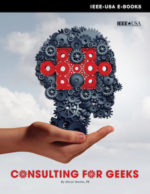Monthly Archives: March 2022
A Humorous Pearl of Wisdom…
Since light travels faster than sound, some people seem bright – until you hear them speak.
— From fellow engineer and blog reader Bob Hofmann
© 2022, https:. All rights reserved.
Troubleshoot like a doctor…Differential Diagnsosis
This is the second in my new series on troubleshooting – a very important skill for all consultants.
The next several posts are from a magazine article for my engineering colleagues, which I have broken into several smaller easy to digest pieces.
Early in my electrical engineering consulting career, a client asked me to explain each step as we worked to improve ESD (electrostatic discharge) immunity on an existing product.
In addition to solving the problem, he wanted to better understand my thinking process. Fair enough, I thought.
At one point, I laid out a “fault tree” of possibilities, along with prescribing a course of action. As it was getting complicated, I apologized for any confusion. The conversation went something like this:
“Not a problem,” my client said, “you are doing differential diagnosis.”
“Stop,” I said, “ what did you just say? And where did you hear that?” Joking, I added, “I’m a consultant — we make our living with buzz words like that.”
Laughing, he responded, “It is a medical term. My brother-in-law is a physician, and we often discuss troubleshooting methods.”
A few weeks after my initial introduction to this concept, I struck up a conversion with a seat mate on a cross country flight. Upon learning he was a doctor with the Mayo Clinic, I asked about differential diagnosis and was treated to a most interesting lecture.
After all, he was a teaching doctor and I was a very willing student. Those of us who teach love these situations.
He began by explaining the father of differential diagnosis was Arthur Conan Doyle (Sherlock Holmes.) Doyle was an MD who also wrote short stories. He had an idea for a detective based on a favorite medical professor who taught clinical diagnosis.
As we all know, the rest is history. It also explains the presence of Holmes medical sidekick, Dr. Watson.
The objective is “rule things in/rule things out” by creating two lists – high probability and low probability. The goal is to quickly narrow down a large list of potential causes to a smaller list, maybe even one likely root cause.
For example, if a patient presents with a red rash, there may be a hundred or more possibilities. Maybe it is the measles, or maybe it is bubonic plague.
The first step is looking at vitals (temperature, blood pressure, etc), which helps quickly eliminate possibilities.
The next step is the physical examination, along with detailed questions. Sometimes an immediate diagnosis can be made — other times additional tests may be necessary.
At that point, the prescription can follow — but not before.
As the Mayo doctor emphasized, “Prescription without Diagnosis is Malpractice.” As an aside, how many of us have thrown solutions at the problem without thinking it through?
Think like a doctor instead.
These chance discussions refined my approach to troubleshooting. But the doctor shared more advice:
If there are multiple possibilities, address the simple ones first (Occam’s razor.) He shared another medical saying, “If you hear the sound of hoofbeats, don’t assume zebras.”
It is probably a horse (unless you are in Africa.) As consultants, we all like to sink our teeth into a juicy problem, but most problems are simple. On rare occasions, however, it well may be a zebra.
He pointed out the Mayo Clinic often deals with “zebras.” There may be a 100 possibilities, and 99 have been ruled out by previous doctors, making it simple for them to identify the zebra.
This is why it is important to ask what has already been done to address the problem.
I learned this lesson the hard way after chasing a problem for several days, only to then discover a very simple solution. It was a bit embassing, but my client was still happy to have the problem solved. But after that, I first looked for simple solutions, going after the “low hanging fruit” no matter what the probability.
This can give rise to a consulting miracle. If there is only a one per cent chance it will work, but it does, everybody thinks you are a genius. When that happens, it is quite a rush 🙂
In the next post, I’ll share a three step process for making the diagnosis dubbed ACT for “Aware-Critque-Act.”
Hope you enjoy this series…
Interested in resurrecting the FREE monthly teleconference? If so, please let me know.
© 2022, https:. All rights reserved.






